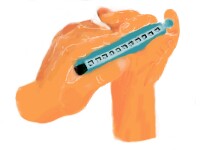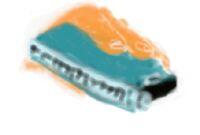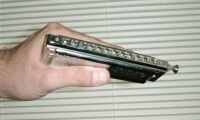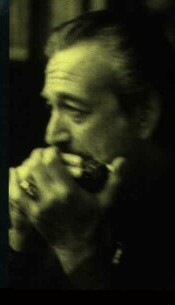

Techniques to get a grip on your axe, and getting tone & effects using your hands.
Thankyou to Doc Harmonica for the use of his photos.
Holding a harmonica is more than just getting the instrument to your mouth and operating the slide button. To get the full tone and wide variety of sounds from a harp you need to learn how to create a seal around the back of the harp and use your hands to control the tone and volume of the harp.
Having said this, flexibility and learning to get a feel for how to mould the tone is important. Try using an approach where you are willing to experiment (when practising) combining your playing techniques with holding and cupping techniques to find effective combinations for various voices, tonal effects, emphasis & feeling.
With the slide to the right, holes facing you and hole numbers visible on the top cover take the harp with your left hand gently holding it between you index finger and thumb, both finger & thumb pointing to the right side of the harp.
Start out by getting the webbing between your finger and thumb against the back of the harp (to the left of) where the cover plates starts to open up. Your left index finger should sit on top of the top cover, towards the back pointing to the right in parallel with the back of the harp.
This is your starting point for a good seal.

|

|
Hold the chrom between your left index finger & thumb
Bring the base of your right thumb, meat and palm up to support the bottom of the harp, slip it behind your left thumb, and point your right thumb and fingers towards the slide, this should all go towards creating a seal along the bottom cover.
Also your right wrist will be almost at right angles to the harp.
Put the pad of the end of your right index finger flat on the button, and keep it there. Whether you use the button or not, when playing a chrom your right index finger must always have solid contact with the button.

Form a seal around the harp.
The right index finger lives on the button
Now curl the second finger on your right hand to rest against the back of the harp just where the cover starts and rest it against the top cover near the back.
To finish the seal you need to get the fingers on the top cover to meet solidly.

Some chromatic harp players use an alternative method to hold the chromatic harp, where the thumb is used to press the button.
Personally I find this method akward, the thumb being what it is works slower than my index finger and effects my playing as a result, also on a 16 hole harmonica I simply don't have the reach in my thumb to get a good solid cup on the lowest octave and use the button at the same time.
The description given to me: "Hold the harmonica in both hands, the left pinky through the index finger of the right hand lying at an angle under the same fingers of the left hand across the top of the harmonica. This creates a hollow at the back for cupping effects, while allowing the right thumb free to work the slide."
Charlie Musselwhite operates the button with his thumb, so it is an effective method.
A spin on this is to press your hands against your face while playing with tongue block, and use your face to complete the seal around the front of the harmonica giving a fuller tone.
Your hold on the chrom can now be turned into a good solid cup.
A harp by itself does not have a particularly large sound bell, which simply consists of two open backed covers. By itself it's pretty tinny and bright, and doesn't have much range for emotion.
But by surrounding it with your mouth, your throat, and your hands in the right way, you can create a larger sound bell, allowing for deeper and more emotional tones. All of these things are dynamic and when controlled give a lot of possibilities to your playing.
A cup can be used to bring the tone and feeling from your harp, it can be used to give feeling, to change the attitude of your tones used in conjunction with the shape of your mouth & embouchure, the position of your tongue, and the strength of your breath.
Push the meat of your left thumb & palm against the meat of your right thumb and palm forming the base of a cup.
The last three fingers on your left hand should be free. Gently squeeze these fingers together and finish forming a 'cup'. The last two fingers on your right hand should also be free, finally gently squeeze these together and rest them on your left hand fingers.
With a bit of practice using this technique you can form a comfortable, tightly sealed cup. When you form this cup and blow and draw a single clear note in the middle register you will be able to feel the push and pull against your hands as the air escapes in & out.
This is easier to do on 12 hole chromatic than a 16 hole because of the size difference. The pictures are based on holding a 12 hole chrom.
When cupping a 16 hole chrom you can focus on getting a good tight seal around the range of holes to be played for a tune. If the whole range of the harp is needed then you will need to occasionally shift your hands to move the focus of the cup and seal. Try to minimize this by getting as big a cup as comfortably possible without compromising the seal.
Using the free two fingers on your right hand and the free three fingers on your left hand you can change the shape of your cup, and you can open and close the cup to varying degrees.
Try playing with this while playing notes to find out what effects this has.
For instance going from a good sealed cup to opening your right fingers up a bit goes from a mellow soft tone to a slightly louder, brighter tone.
Opening your hands right up gives you the ability to play loudly and brighter.
Also a few harmonica players have commented to me to bring the palms closer together behind the harp (around the bass notes), and open up the fingers around the higher notes allows for a more consistant and better projection of volume across the instrument.
Combined with the strength of your notes you can get a lot of feeling into your tones using your hands.
Remember though, a lot of tone control also comes from how you play the harmonica, it isn't just in the hands.
This is similar to an effect horn musicians can play where the sound is varied repeatedly between muffled and loud & clear.
By going quickly from a good cup to open hands and back to a cup repeatedly you get the wah wah effect.
Do this by lifting your free right fingers, followed immediately with your free left fingers in one smooth motion, and reverse the action back to a sealed cup.
Experiment. Try varying the speed that you open and close your cup, vary the distance you open your fingers up. Try increasing and reducing the strength of your notes with your breath in time with opening and closing your cup on the harp.
With cupped microphone you can get away with just using a finger or two.
This is a far more subtle motion than the wah wah. It can be good for varing a long note, or for a bit of effect to add feeling in a tune.
Start with a good cup, then simply flutter your free right fingers to slightly open and close your cup.
Try experimenting with the speed and extent you do this. See what effect not quite closing the cup has versus almost slapping your fingers closed.
With cupped microphone you can get away with just fluttering a finger or two.
Its far too easy to use too much of this effect, use with discretion.
There are a few ways you can play using a microphone: